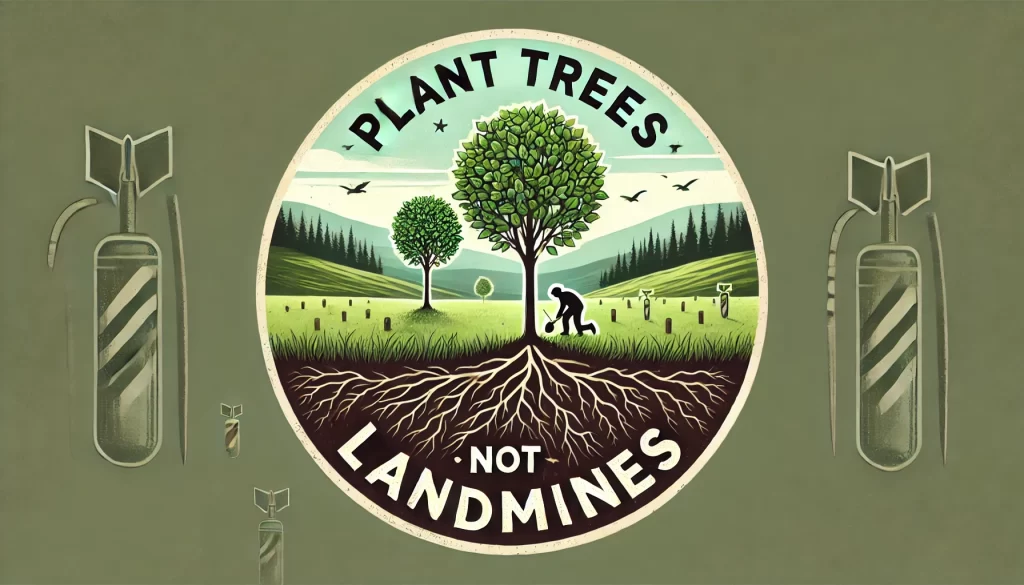
In life, we walk paths without fully considering the impact of each step. And with every decision, we either create smoother journeys for others or leave obstacles behind. This is not just a metaphor for leadership – it’s a reflection of how we shape the spaces around us. Those in positions of influence – whether in business, education, or community – make decisions that ripple far beyond their immediate effects.
The choices we make are like footprints—either leaving a path for others to follow or creating obstacles that lead to conflict. You can either plant trees, which offer care and comfort to others and yourself, or lay landmines, which create no-go zones for everyone, including you.
The key question to always ask is: Why build a landscape that even you can’t navigate?
A tree is an investment. It takes time to grow but offers shade, shelter, and sustenance for years to come. It supports life, creating an environment where others can thrive. When you plant trees, you invest in a future that benefits not just you, but all who follow. The tree becomes a place of rest and growth, for you and others alike.
Contrast that with a landmine – set with one intent: destruction. It serves no purpose other than to harm when triggered. Worse still, no one is immune to its impact. The person who plants it often forgets that the landmine blocks their own path, too. Over time, landmines don’t just trap others; they limit the freedom of the very person who placed them.
This is an analogy that I often share with my students. To me, it’s about teaching them to see beyond their immediate actions. Too often, we’re tempted to chase quick wins or resolve problems with short-term solutions. But if you spend your life setting traps – creating conflicts, burning bridges – you’ll eventually find yourself caught in your own minefield. Leadership is not about laying obstacles; it’s about clearing the way for others.
This is where intentionality and humility become critical. You can’t plant trees without being mindful of your choices. In leadership, as in life, the outcomes you seek tomorrow are the seeds you plant today. Thoughtful actions today will nurture environments where others can succeed – and their success will, in turn, foster your own growth. It’s a reciprocal cycle, a network of support that benefits everyone.
However, not all landmines are laid intentionally. Sometimes, they result from carelessness or a lack of foresight. Too much comfort and too little thought can lead to outcomes most wouldn’t typically associate with a landmine.
That’s why self-awareness is crucial.
Ask yourself: What am I leaving behind? Is it something that others can build on, or something they’ll have to carefully navigate around?
Leadership theory often celebrates boldness and risk-taking. But lasting leadership – the kind that endures – is more about planting forests than chasing immediate rewards. It’s the slow, deliberate work of creating environments that allow others to flourish. Leaders who plant trees create legacies that last beyond their tenure, while those who lay landmines leave behind nothing but problems for future generations to solve.
Look at any great leader, and you’ll see a pattern of tree planting. These individuals weren’t focused on quick results or personal gain. They invested in frameworks that allowed others to succeed, knowing that the benefits of their work would outlive them. Contrast this with leaders who laid landmines – whose decisions were driven by short-term thinking or selfish goals. Over time, their legacies faded, marked only by the barriers they left behind.
As you walk your own path – whether as a leader, professional, or simply someone navigating life – the choice remains the same. Every conversation, project, and decision is an opportunity to either plant trees or lay landmines.
Planting trees means building something lasting that benefits both you and those around you. Laying landmines may, at the time, seem like a quick solution, but you’ll find yourself stuck in the very traps you set for others. So, be thoughtful. Be intentional. Think long-term. The path you create is the one you’ll eventually walk.
While I came up with this analogy while explaining a core leadership concept to my students, this lesson isn’t just for them – it’s for all of us. It’s a reminder worth revisiting as we navigate the complexities of work, leadership, and life.
What will you leave behind? A landscape full of trees, or a minefield waiting to explode?
The choice is yours – Every Day.